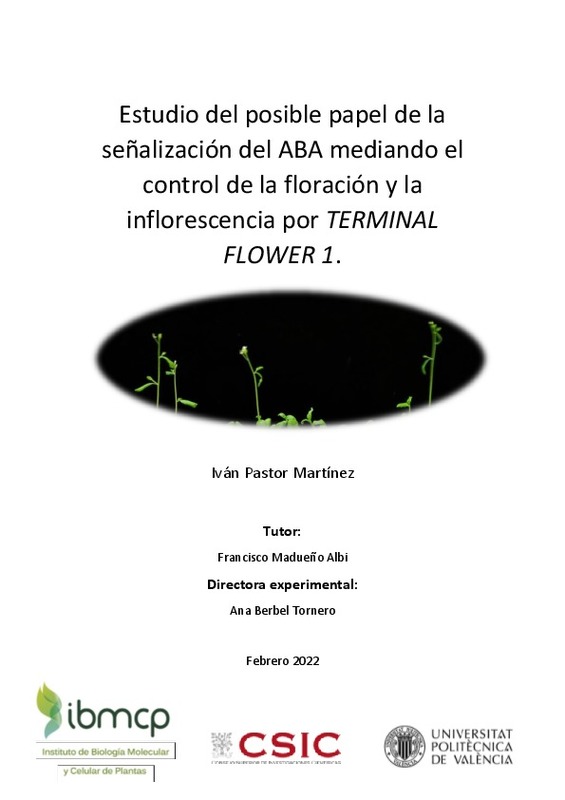|
Resumen:
|
[ES] Las plantas han adoptado un desarrollo post-embrionario en el que a partir de los meristemos
apicales que se forman durante la embriogénesis surgen el resto de las estructuras que formarán
la planta adulta. Uno de ...[+]
[ES] Las plantas han adoptado un desarrollo post-embrionario en el que a partir de los meristemos
apicales que se forman durante la embriogénesis surgen el resto de las estructuras que formarán
la planta adulta. Uno de estos meristemos es el meristemo apical del tallo (SAM, Shoot Apical
Meristem en inglés) compuesto por células madre que pueden diferenciarse en células que den
lugar al tallo o a meristemos secundarios.
Arabidopsis thaliana sufre dos etapas tras la germinación, en primer lugar, una vegetativa en la
que le meristemo genera hojas y una fase reproductiva en la que el meristemo es capaz de
formar flores. Este paso de fase vegetativa a fase reproductiva se conoce como transición floral.
El SAM adquiere una identidad indeterminada durante la transición floral para entrar a la fase
de desarrollo. Este cambio del SAM está regulado por un complejo circuito de rutas genéticas
que perciben y responden a diversos estímulos ambientales (fotoperiodo, intensidad lumínica,
temperatura, disponibilidad de nutrientes) y endógenos (edad, el estado hormonal, niveles de
sacarosa). Entre los genes que regulan la floración se encuentran FLOWERING LOCUS T (FT) y
TERMIAL FLOWER 1 (TFL1) que forman parte de la familia de las proteínas PEBPs pero que tienen
funciones opuestas. Mientras que FT promueve la floración, TFL1 la reprime.
En experimentos previos de ChIP-seq de TFL1 realizados en nuestro laboratorio se encontraron
genes diana que juegan un papel en la señalización del ácido abscísico (ABA). El papel del ABA
en la floración no es desconocido, pero existe controversia ya que se observa tanto un papel
positivo como uno negativo.
Debido a las preguntas que esto genera, en este Trabajo de Fin de Master se ha intentado
ahondar en la conexión entre TFL1 y el ABA. Para ello, se ha estudiado el papel de ANAC102,
HAI1 y MYB3, genes reguladores de la señalización del ABA, en la floración y su posible papel
con TFL1. Para ello se ha analizado el patrón de expresión de estos genes, así como se han
caracterizado, a nivel de procesos regulados por TFL1, el fenotipo de mutantes de pérdida de
función y de sobrexpresión de estos genes. Además, se ha profundizado más en el papel
conjunto de TFL1 y GBF3 en la floración estudiando la posible interacción proteína-proteína y
caracterizando el doble mutante tfl1-1 gbf3 y la sobrexpresión de GBF3 en Col-0 y tfl1-1 en
cuanto al fenotipo asociado a la transición floral.
[-]
[EN] Plants have adopted a post-embryonic development in which from the apical meristems formed during embryogenesis the apical meristems formed during embryogenesis give rise to the rest of the structures that will form ...[+]
[EN] Plants have adopted a post-embryonic development in which from the apical meristems formed during embryogenesis the apical meristems formed during embryogenesis give rise to the rest of the structures that will form the adult plant. One of these meristems is the shoot apical meristem (SAM, Shoot Apical Meristem) composed of stem cells that can differentiate into cells that give rise to the stem or to meristems that can stem or secondary meristems. Arabidopsis thaliana undergoes two stages after germination, first, a vegetative stage in which the meristem generates leaves and secondary meristems.first, a vegetative stage in which the meristem generates leaves, and a reproductive stage in which the meristem is capable of forming flowers. This transition from the vegetative to the reproductive phase is known as the floral transition. The SAM acquires an indeterminate identity during the floral transition to enter the developmental phase. This change of the SAM is regulated by a complex circuit of genetic pathways that sense and respond to various environmental stimuli (photoperiod, light intensity, temperature, nutrient availability) and endpoints, temperature, nutrient availability) and endogenous stimuli (age, hormonal status, sucrose levels). Among the genes that regulate flowering are FLOWERING LOCUS T (FT) and
TERMIAL FLOWER 1 (TFL1), which are part of the PEBPs family of proteins but have opposite functions. While FT promotes flowering, TFL1 represses it.
In previous TFL1 ChIP-seq experiments performed in our laboratory, we found target genes that play a role in abscisic acid (ABA) signaling. The role of ABA in flowering is not unknown, but controversy exists as both a positive and a negative role is observed. Because of the questions that this raises, this Master's thesis has attempted to the connection between TFL1 and ABA. For this purpose, the role of ANAC102 has been studied,
HAI1 and MYB3, regulatory genes of ABA signaling, in flowering and their possible role with TFL1. with TFL1. For this purpose, the expression pattern of these genes has been analyzed, as well as the characterization, at the level of regulatory processes, of the the phenotype of loss-of-function and overexpression mutants of these genes were characterized at the level of TFL1-regulated processes. and overexpression mutants of these genes have been characterized at the level of TFL1-regulated processes. In addition, the joint role of TFL1 and GBF1 has been of TFL1 and GBF3 in flowering by studying the possible protein-protein interaction and by characterizing the tfl1 and GBF3 characterizing the tfl1-1 gbf3 double mutant and GBF3 overexpression in Col-0 and tfl1-1 transition.
[-]
|







